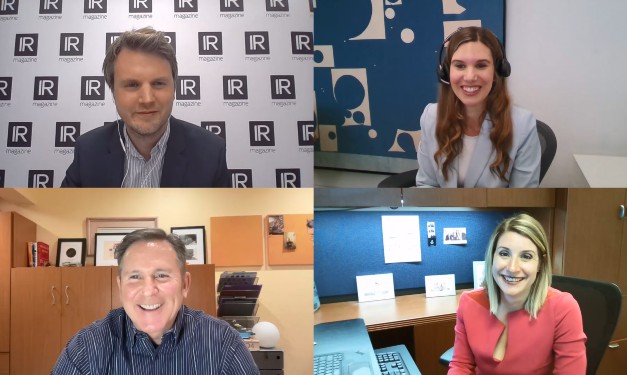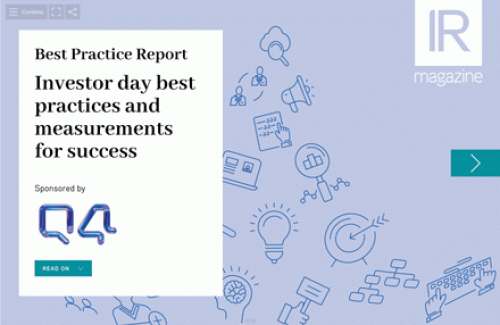An investor day is arguably the single-most important moment in the IR calendar. It’s a rare chance to reframe your investment case, introduce new executives and provide a much deeper view into the company and its culture.
So how can companies make the most of this key opportunity? This week, IR Magazine, in partnership with Q4, held a webinar looking at how companies can be innovative with their investor days, while also following best practices around planning, execution and follow-up. Below, we round up nine takeaways from the discussion.

The why is crucial…
A key question to ask yourself about investor days is why you are putting one on, explained the panel. ‘Do I have anything to share? What’s my objective with this event? You want to go with an investor day when you have something to say,’ said Valerie Durand, head of IR and corporate sustainability at Air Canada, which won best investor event at the IR Magazine Awards – Canada 2023.
Align your timing with business planning
Ideally, the timing of an investor day should match up with what’s going on at the company, said John Nunziati, assistant vice president and IR partner at Q4. ‘I think the alignment with the strategic planning cycle, or the annual financial planning cycle, is really critical,’ he said. ‘Often [when] you think about an investor day, you think about a long-term financial model or a new lot of annual guidance. If you’re trying to do that mid-year, your company isn’t going to have the data prepared that you might need.’
There’s value in a yearly event but you need to bring the ‘sizzle’
Holding an annual investor day is a huge undertaking, but gives you critical time each year with investors to get across your story and build relationships, said Charlotte Thuot Kucyi, senior manager of IR at Tricon Residential and winner of the rising star award at the IR Magazine Awards – Canada. ‘You definitely have to keep the ‘sizzle’ going year after year,’ she noted. ‘For example, this year we focused on the technology that powers our resident experience.’
Get your hands dirty with the script
IR professionals are the gatekeepers of investor-day messaging and understanding how it will resonate with investors, said Durand, so they need to ‘get their hands dirty’ and make sure their feedback is being incorporated. ‘You don’t want to have a message that is not hitting the mark or not resonating with your audience, and you are the best one to know what will and will not work,’ she said.
Companies are split between virtual and hybrid
During the pandemic, virtual became the only option available for most investor days. But now societies have opened up again, the pendulum has swung back and there is currently a roughly even split between companies opting for virtual and hybrid events, said Nunziati. Hybrid events are very different now compared with before the pandemic, he added: ‘We’re really seeing a much more immersive hybrid experience… and video has become pretty standard. We see more than 85 percent of companies using video in the events we’re hosting.’
Entice people to travel
The flipside of a great virtual experience is that investors may be reluctant to travel to the event in person. Durand said her company enticed people to come by offering a glimpse of the inner workings of the business. ‘We organized, for example, simulator rides so that people could see what it’s like to train as a pilot,’ she said. ‘We had people visiting our operations center, which is phenomenal to see. And then we organized morning skates with NHL players to leverage the commercial sponsorships we have.’
Make sure everyone can interact
Audience participation is crucial to keep people engaged, and that should include both in-person and virtual attendees, said Thuot Kucyi. ‘We allowed live questions from both those in the room and virtually after each section,’ she explained. ‘It’s difficult with virtual events – you don’t want people interrupting too much – but you want to make sure people can ask their questions.’
Break people into groups
Nunziati suggested breaking up your main party into smaller groups outside of the main presentations. ‘If you’re planning to do any kind of tours or interactions, where people are going to be walked around physically or shown things outside of sitting in a presentation room, that has to be done in smaller groups,’ he said. You can also group investors for social events, he noted – for example, getting executives to rotate tables during a lunch or dinner.
Fall in love with the process
Thuot Kucyi said her biggest piece of advice for IROs taking on an investor day is to fall in love with the planning of the event. ‘That one day is going to go by so fast,’ she said. ‘So you have to love the process of doing it. You have to love getting in the weeds, learning about your business, getting to know people… because that’s going to be your year, versus the one day.’










